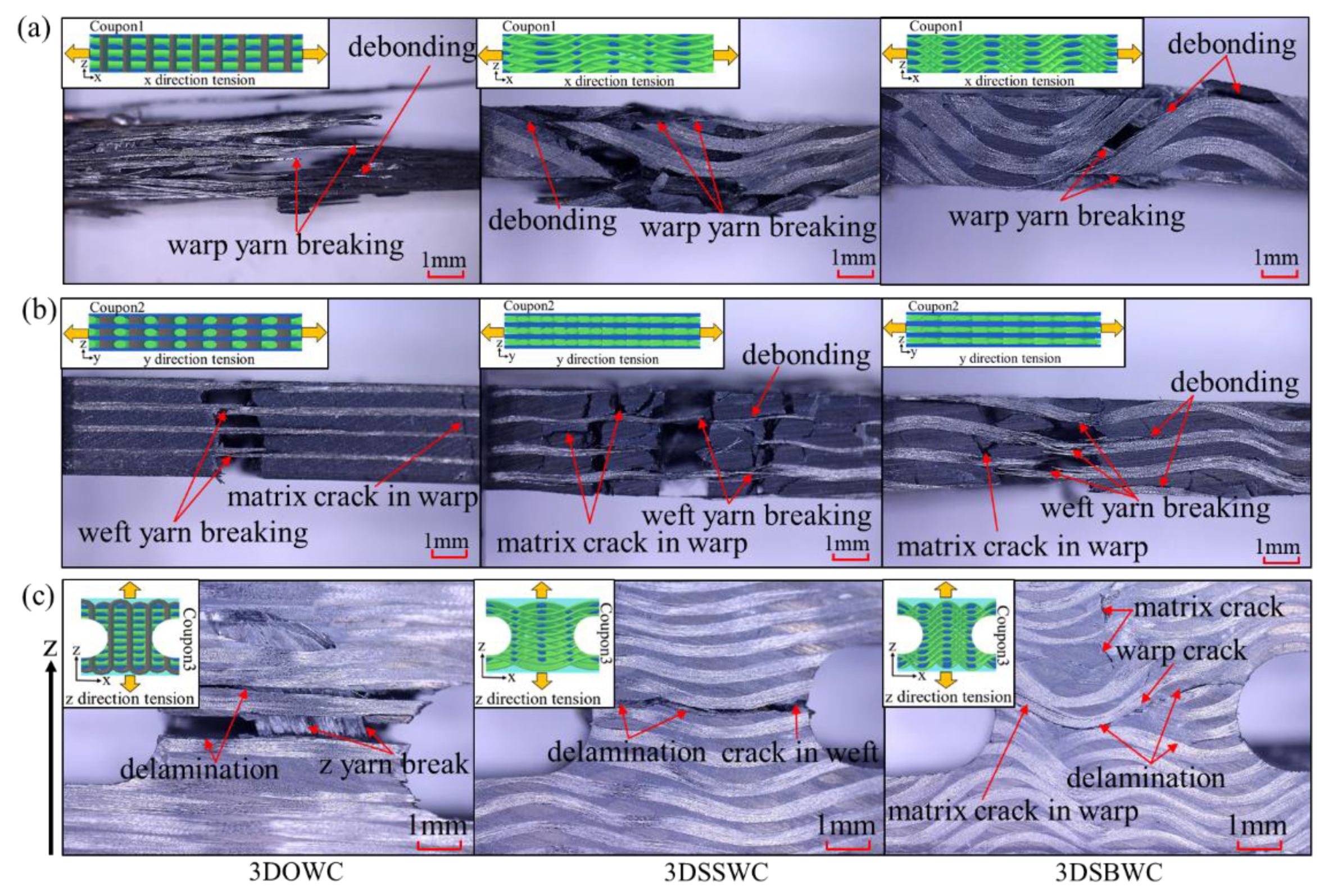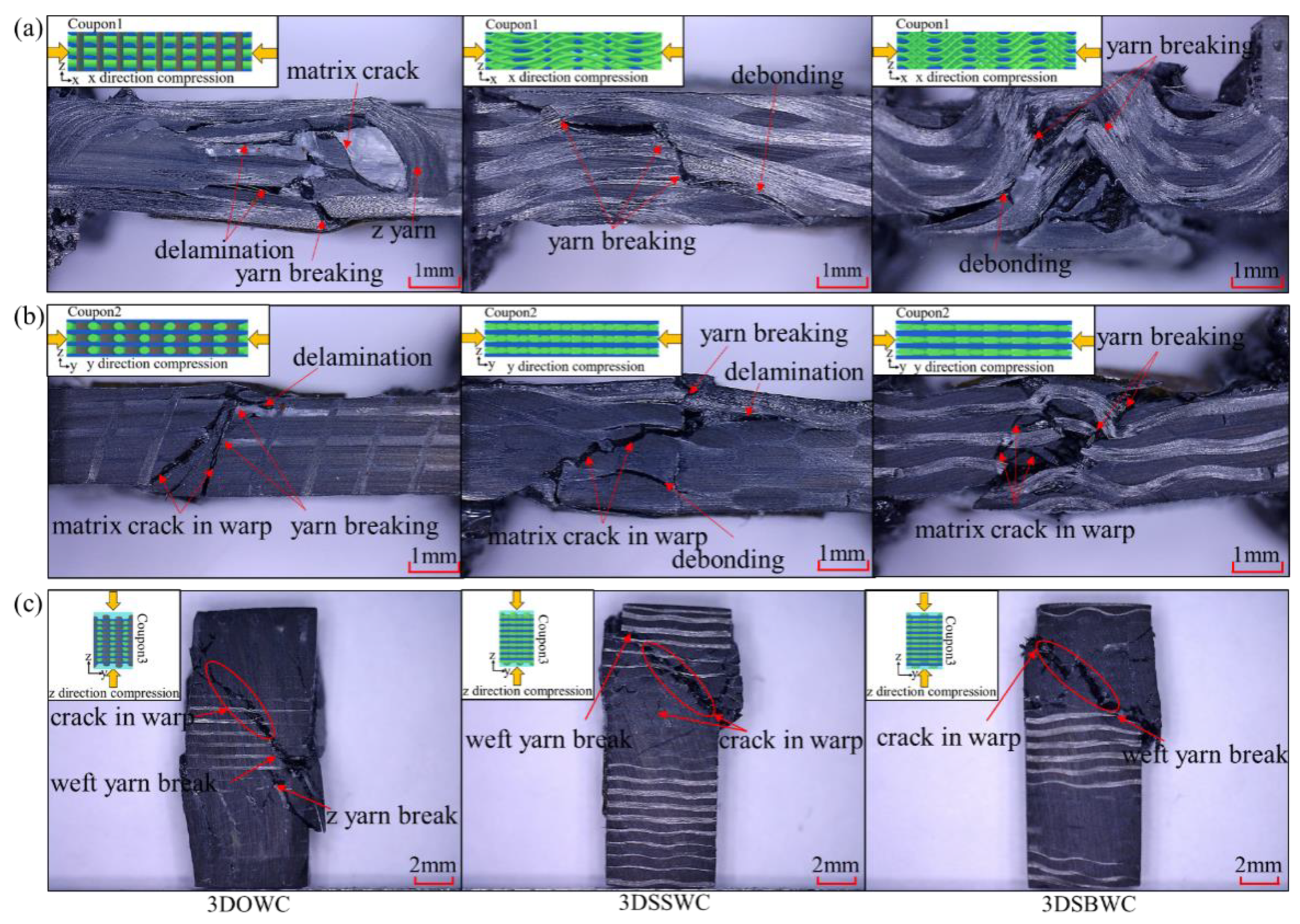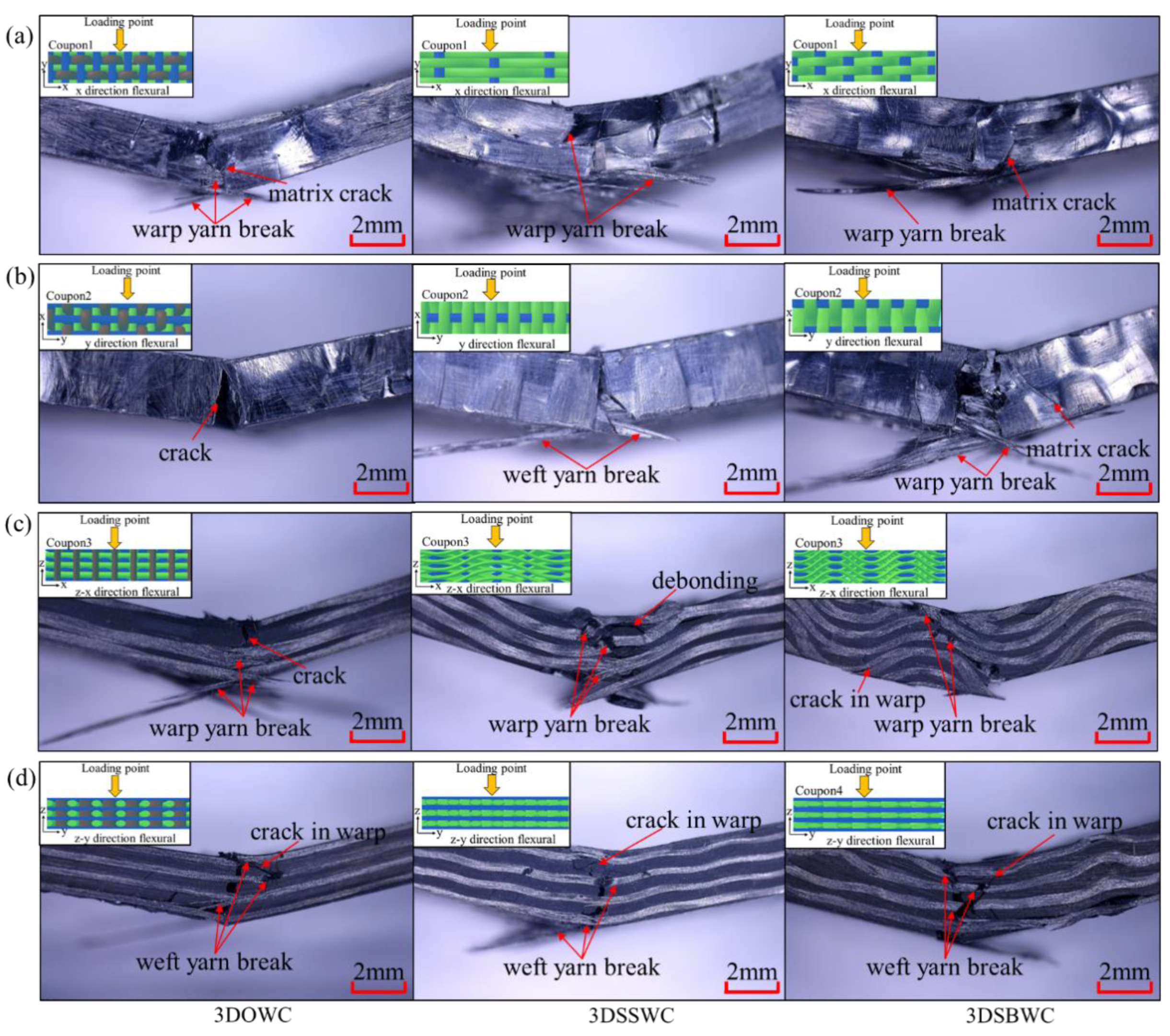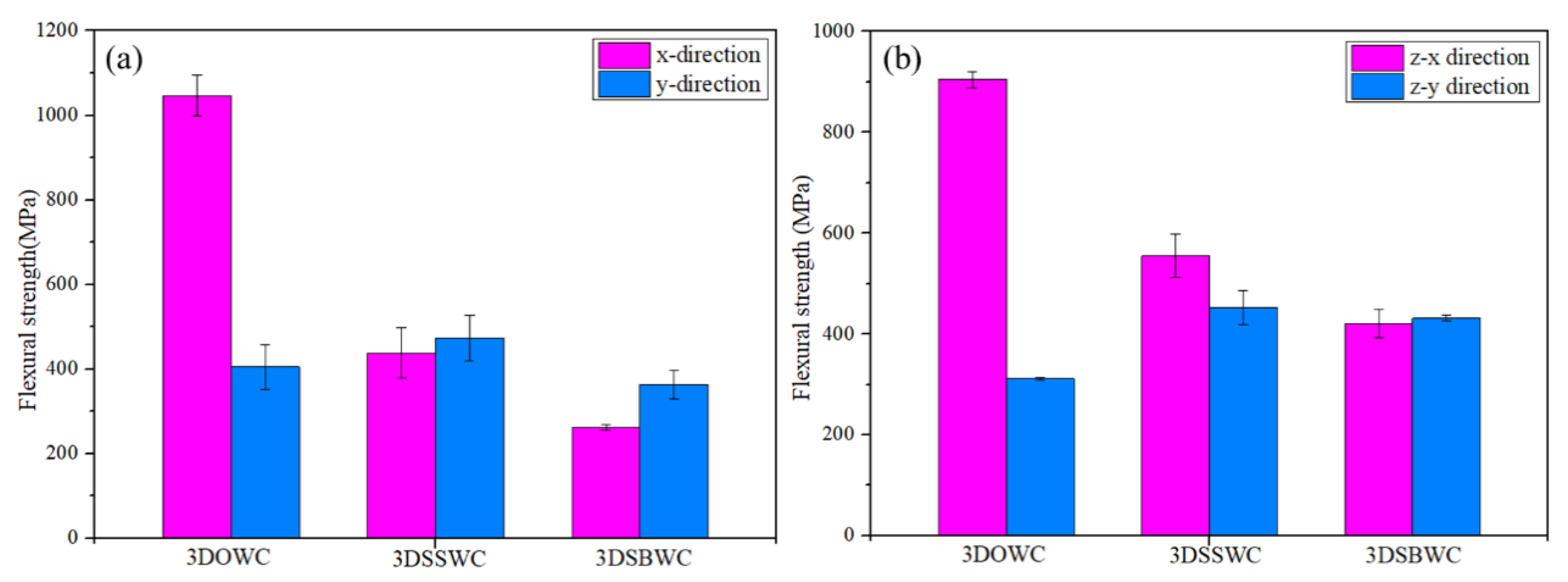A Comprehensive Study on the Mechanical Properties of Different 3D Woven Carbon Fiber-Epoxy Composites
Abstract
:1. Introduction
2. Materials and Methods
2.1. Materials
2.2. Fabrication of the Composites
2.3. Characterization of the Mechanical Properties
3. Results and Discussion
3.1. Fiber Volume Fraction
3.2. Morphology of Woven Fabrics
3.3. Microstructure Analysis of Composites
3.4. Tensile Test
3.4.1. In-Plane Tension (x and y-Direction)
3.4.2. Out-Plane Tension (z-Direction)
3.5. Compression Test
3.5.1. In-Plane Compression (x and y-Direction)
3.5.2. Out-Plane Compression (z-Direction)
3.6. Flexural Test
3.6.1. In-Plane Flexural Strength
3.6.2. Out-Plane Flexural
4. Conclusions
Supplementary Materials
Author Contributions
Funding
Conflicts of Interest
References
- Mouritz, A.P.; Bannister, M.K.; Falzon, P.J.; Leong, K.H. Review of applications for advanced three-dimensional fibre textile composites. Compos. Part A-Appl. Sci. Manuf. 1999, 30, 1445–1461. [Google Scholar] [CrossRef]
- Guénon, V.A.; Chou, T.W.; Gillespie, J.W. Toughness properties of a three-dimensional carbon-epoxy composite. J. Mater. Sci. 1989, 24, 4168–4175. [Google Scholar] [CrossRef]
- Ivanov, D.S.; Lomov, S.V.; Bogdanovich, A.E.; Karahan, M.; Verpoest, I. A comparative study of tensile properties of non-crimp 3D orthogonal weave and multi-layer plain weave E-glass composites. Part 2: Comprehensive experimental results. Compos. Part A Appl. Sci. Manuf. 2009, 40, 1144–1157. [Google Scholar] [CrossRef]
- Gokarneshan, N.; Alagirusamy, R. Weaving of 3D fabrics: A critical appreciation of the developments. Text. Prog. 2009, 41, 1–58. [Google Scholar] [CrossRef]
- Golra, O.A.; Tariq, J.; Ehsan, N.; Mirza, E. Strategy for introducing 3D fiber reinforced composites weaving technology. Proc. Tech. 2012, 1, 211–216. [Google Scholar] [CrossRef] [Green Version]
- Brandt, J.; Drechsler, K.; Mohamed, M.; Gu, P.U. Manufacture and Performance of Carbon/Epoxy 3-D Woven Composites; Society for the Advancement of Material and Process Engineering: Covina, CA, USA, 1993. [Google Scholar]
- Arendts, F.J.; Drechsler, K.; Brandt, J. Advanced Textile Structural Composites–Status and Outlook; TMS: Pittsburgh, PA, USA, 1993. [Google Scholar]
- Brandt, J.; Drechsler, K.; Arendts, F.J. Mechanical performance of composites based on various three-dimensional woven-fibre preforms. Compos. Sci. Technol. 1996, 56, 381–386. [Google Scholar] [CrossRef]
- Drechsler, K. 2–3-D textile reinforced composites for the transportation industry. In 3-D Textile Reinforcements in Composite Materials; CRC Press: Boca Raton, FL, USA, 1999; pp. 43–66. [Google Scholar]
- Nasution, M.R.E.; Watanabe, N.; Kondo, A.; Yudhanto, A. A novel asymptotic expansion homogenization analysis for 3-D composite with relieved periodicity in the thickness direction. Compos. Sci. Technol. 2014, 97, 63–73. [Google Scholar] [CrossRef]
- Liu, X.; Rouf, K.; Peng, B.; Yu, W. Two-step homogenization of textile composites using mechanics of structure genome. Compos. Struct. 2017, 171, 252–262. [Google Scholar] [CrossRef]
- Tan, P.; Tong, L.; Steven, G.P.; Ishikawa, T. Behavior of 3D orthogonal woven CFRP composites. Part I. Experimental investigation. Compos. Part A 2000, 31, 259–271. [Google Scholar] [CrossRef]
- Leong, K.H.; Lee, B.; Herszberg, I.; Bannister, M.K. The effect of binder path on the tensile properties and failure of multilayer woven CFRP composites. Compos. Sci. Technol. 2000, 60, 149–156. [Google Scholar] [CrossRef]
- Tan, P.; Tong, L.; Steven, G.P.; Ishikawa, T. Behavior of 3D orthogonal woven CFRP composites. Part II. FEA and analytical modeling approaches. Compos. Part A Appl. Sci. Manuf. 2000, 31, 273–281. [Google Scholar] [CrossRef]
- Quinn, J.P.; Mcilhagger, A.T.; Mcilhagger, R. Examination of the failure of 3D woven composites. Compos. Part A Appl. Sci. Manuf. 2008, 39, 273–283. [Google Scholar] [CrossRef]
- Bogdanovich, A.E.; Karahan, M.; Lomov, S.V.; Verpoest, I. Quasi-static tensile behavior and damage of carbon/epoxy composite reinforced with 3D non-crimp orthogonal woven fabric. Mech. Mater. 2013, 62, 14–31. [Google Scholar] [CrossRef]
- Zhang, F.; Liu, K.; Wan, Y.; Jin, L.; Gu, B.; Sun, B. Experimental and numerical analyses of the mechanical behaviors of three-dimensional orthogonal woven composites under compressive loadings with different strain rates. Int. J. Damage Mech. 2013, 23, 636–660. [Google Scholar] [CrossRef]
- Kuo, W.S.; Ko, T.H. Compressive damage in 3-axis orthogonal fabric composites. Compos. Part A Appl. Sci. Manuf. 2000, 31, 1091–1105. [Google Scholar] [CrossRef]
- Cox, B.N.; Dadkhah, M.S.; Inman, R.V.; Morris, W.L.; Zupon, J. Mechanisms of compressive failure in 3D composites. Acta Metall. Et Mater. 1993, 40, 3285–3298. [Google Scholar] [CrossRef]
- Turner, P.; Liu, T.; Zeng, X. Collapse of 3D Orthogonal Woven Carbon Fibre Composites Under In-plane Tension/Compression and Out-of-plane Bending. Compos. Struct. 2016, 142, 286–297. [Google Scholar] [CrossRef]
- Huang, G.; Zhong, Z. Tensile behavior of 3D woven composites by using different fabric structures. Mater. Des. 2002, 23, 671–674. [Google Scholar]
- Jin, L.; Niu, Z.; Jin, B.C.; Sun, B.; Gu, B. Comparisons of static bending and fatigue damage between 3D angle-interlock and 3D orthogonal woven composites. J. Reinf. Plast. Compos. 2012, 31, 935–945. [Google Scholar] [CrossRef]
- Liu, Y.; Zhu, J.; Chen, Z.; Jiang, Y. Mechanical behavior of 2.5D (shallow straight-joint) and 3D four-directional braided SiO 2f /SiO2 composites. Ceram Int. 2012, 38, 4245–4251. [Google Scholar] [CrossRef]
- Warren, K.C.; Lopez-Anido, R.A.; Goering, J. Experimental investigation of three-dimensional woven composites. Compos. Part A Appl. Sci. Manuf. 2015, 73, 242–259. [Google Scholar] [CrossRef]
- Dai, S.; Cunningham, P.R.; Marshall, S.; Silva, C. Influence of fibre architecture on the tensile, compressive and flexural behaviour of 3D woven composites. Compos. Part A Appl. Sci. Manuf. 2015, 69, 195–207. [Google Scholar] [CrossRef] [Green Version]
- Behera, B.K.; Dash, B.P. Mechanical behavior of 3D woven composites. Mater. Des. 2015, 67, 261–271. [Google Scholar] [CrossRef]
- Dai, S.; Cunningham, P.R.; Marshall, S.; Silva, C. Open hole quasi-static and fatigue characterisation of 3D woven composites. Compos. Struct. 2015, 131, 765–774. [Google Scholar] [CrossRef] [Green Version]
- ASTM D4762. Standard Guide for Testing Polymer Matrix Composite Materials; ASTM International: West Conshohocken, PA, USA, 2011. [Google Scholar]
- Broughton, W.R. 8–Through-thickness testing*. Mech. Test. Adv. Fibre Compos. 2000, 39, 143–169. [Google Scholar]
- Lodeiro, M.J.; Broughton, W.R.; Sims, G.D. Understanding limitations of through thickness test methods. Plast. Rubber Compos. 1999, 28, 416–424. [Google Scholar] [CrossRef]
- Rudov-Clark, S.; Mouritz, A.P.; Lee, L.; Bannister, M.K. Fibre damage in the manufacture of advanced three-dimensional woven composites. Compos. Part A Appl. Sci. Manuf. 2003, 34, 963–970. [Google Scholar] [CrossRef]
- Mahadik, Y.; Hallett, S.R. Effect Of Fabric Compaction And Yarn Waviness On 3D Woven Composite Compressive Properties. Compos. Part A Appl. Sci. Manuf. 2011, 42, 1592–1600. [Google Scholar] [CrossRef]









| Structures | Thickness (mm) | Warp Density (Pick/cm) | Weft Density (Pick/cm) | Layers (Warp/Weft) | Fiber Volume Fraction (%) |
|---|---|---|---|---|---|
| 3DOW | 16.5 | 9.0 | 2.0 | 21/22 | 44.3 |
| 3DSSW | 17.0 | 9.0 | 3.4 | 21/21 | 45.5 |
| 3DSBW | 16.0 | 9.0 | 3.3 | 21/22 | 47.7 |
© 2020 by the authors. Licensee MDPI, Basel, Switzerland. This article is an open access article distributed under the terms and conditions of the Creative Commons Attribution (CC BY) license (http://creativecommons.org/licenses/by/4.0/).
Share and Cite
Hu, Q.; Memon, H.; Qiu, Y.; Liu, W.; Wei, Y. A Comprehensive Study on the Mechanical Properties of Different 3D Woven Carbon Fiber-Epoxy Composites. Materials 2020, 13, 2765. https://doi.org/10.3390/ma13122765
Hu Q, Memon H, Qiu Y, Liu W, Wei Y. A Comprehensive Study on the Mechanical Properties of Different 3D Woven Carbon Fiber-Epoxy Composites. Materials. 2020; 13(12):2765. https://doi.org/10.3390/ma13122765
Chicago/Turabian StyleHu, Qiaole, Hafeezullah Memon, Yiping Qiu, Wanshuang Liu, and Yi Wei. 2020. "A Comprehensive Study on the Mechanical Properties of Different 3D Woven Carbon Fiber-Epoxy Composites" Materials 13, no. 12: 2765. https://doi.org/10.3390/ma13122765









